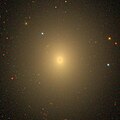| NGC 4494 | |
|---|---|
 NGC 4494 by 2MASS | |
| Observation data (J2000 epoch) | |
| Constellation | Coma Berenices |
| Right ascension | 12h 31m 24.1s [1] |
| Declination | +25° 46′ 31″ [1] |
| Redshift | 1342 ± 5 km/s [1] |
| Distance | 45 ± 10 Mly (13.7 ± 3.2 Mpc) [1] |
| Apparent magnitude (V) | 9.7 [2] |
| Characteristics | |
| Type | E1–2 [1] |
| Apparent size (V) | 4.8′ × 3.5′ [1] |
| Other designations | |
| UGC 7662, MCG +04-30-002, PGC 41441 [1] | |
NGC 4494 is an elliptical galaxy located in the constellation Coma Berenices. It is located at a distance of circa 45 million light years from Earth, which, given its apparent dimensions, means that NGC 4494 is about 60,000 light years across. It was discovered by William Herschel in 1785.

